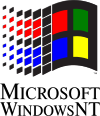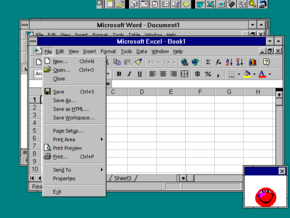- Windows NT 3.51
-
Windows NT 3.51 Part of the Microsoft Windows family 

Screenshot of Windows NT 3.51 Developer Microsoft Releases Release date 30 May 1995[info] Current version 3.51 (Build 1057: Service Pack 5) (September 19, 1996)[info] Source model Closed source License MS-EULA Kernel type Hybrid Platform support IA-32, Alpha, MIPS, PowerPC Preceded by Windows NT 3.5 Succeeded by Windows NT 4.0 Support status Unsupported as of 31 December 2001 Windows NT 3.51 is the third release of Microsoft's Windows NT line of operating systems. It was released on 30 May 1995, nine months after Windows NT 3.5. The release provided two notable feature improvements; firstly NT 3.51 was the first of a short-lived outing of Microsoft Windows on the PowerPC architecture. The second most significant enhancement offered through the release was that it provides client/server support for interoperating with Windows 95, which was released three months after NT 3.51. Windows NT 4.0 became its successor a year later; Microsoft continued to support 3.51 until 31 December 2001.
Contents
Overview
The release of Windows NT 3.51 was dubbed "the PowerPC release" at Microsoft. The original intention was to release a PowerPC edition of NT 3.5, but according to Microsoft's David Thompson, "we basically sat around for 9 months fixing bugs while we waited for IBM to finish the Power PC hardware".[1] Editions of NT 3.51 were also released for the x86, MIPS, and Alpha architectures.
New features introduced in Windows NT 3.51 include PCMCIA support, NTFS file compression,[2] replaceable WinLogon (GINA), 3D support in OpenGL, persistent IP routes when using TCP/IP, automatic display of textual descriptions when the mouse pointer was placed on toolbar buttons ("tooltips") and support for Windows 95 common controls.[3]
Despite the significant difference in the kernel base, Windows NT 3.51 is readily able to run a large number of Win32 applications designed for Windows 95. Most recent 32-bit applications will not work as the developers have prevented their application from working with any Windows version earlier than Windows 98, also because some applications do not work properly with the older Windows NT 3.51 interface. Despite this, Microsoft in their application releases muddied the issue, releasing 32-bit versions of Microsoft Office right up to Office 97 SR2b, but relying upon 16-bit versions of Internet Explorer technology. This is probably because 32-bit versions of Internet Explorer 4.0 and later integrated with the Windows 95 desktop, and NT 3.51 still used the Windows 3.1 desktop. Later on, up to IE 5.0, but not later 5.x versions, were offered.
NewShell
On 26 May 1995, Microsoft released a test version of a shell refresh, named the Shell Technology Preview, and often referred to informally as "NewShell". This was the first incarnation of the modern Windows GUI with the Taskbar and Start menu. It was designed to replace the Windows 3.x Program Manager/File Manager based shell with Windows Explorer-based graphical user interface. The release provided capabilities quite similar to that of the Windows "Chicago" (codename for Windows 95) shell during its late beta phases; however, it was intended to be nothing more than a test release.[4] There was a second public release of the Shell Technology Preview, called Shell Technology Preview Update made available to MSDN and CompuServe users on 8 August 1995. Both releases held Windows Explorer builds of 3.51.1053.1. The Shell Technology Preview program never saw a final release under NT 3.51. The entire program was moved across to the Cairo development group who finally integrated the new shell design into the NT code with the release of NT 4.0 in July 1996.
Five Service Packs were released for NT 3.51, which introduced both bug fixes and new features. Service Pack 5, for example, fixed issues related to the Year 2000 problem.
NT 3.51 was the last of the series to run on an Intel 80386 processor. This, its ability to use HPFS partitions (which Windows 2000 and later could not),[5] and its ability to run at least some of the common control API, means that it still finds a place for occasional use on older machines. Windows NT 3.51, like other versions of Windows NT.3x, has some compatibility with OS/2 1.x Applications; however, the applications were to be in text mode.
Hardware requirements
Windows NT 3.51 hardware requirements[6] "Windows NT Workstation" "Windows NT Server" Processor 386 or 486/25 processor 386 or 486/25 processor Memory 12 MB RAM 16 MB RAM Video VGA video VGA video Hard disk drive free space 90 MB 90 MB Windows NT 3.51 supports IDE, EIDE, SCSI and ESDI hard drives. The only EIDE addressing schemes supported are Logical block addressing, ONTrack Disk Manager, EZDrive, and Extended cylinder-head-sector.
References
- ^ Paul Thurrott (24 January 2003). "Windows Server 2003: The Road To Gold - Part One: The Early Years". SuperSite for Windows. http://www.winsupersite.com/reviews/winserver2k3_gold1.asp. Retrieved 4 September 2009.
- ^ Optimizing NTFS
- ^ Windows NT 3.51 Product Overview
- ^ John D. Ruley (September 1995). "NT Gets the Look But Not the Logo". How-To Columns. WinMag. Archived from the original on 14 March 2006. http://web.archive.org/web/20060314223207/http://winmag.com/library/1995/0995/09howtoc.htm. Retrieved 4 September 2009. Internet Archive
- ^ "Overview of FAT, HPFS, and NTFS File Systems". Microsoft. 7 May 2007. http://support.microsoft.com/kb/100108. Retrieved 4 September 2009.
- ^ "Windows NT 3.5x Setup Troubleshooting Guide". Microsoft. 1 November 2006. http://support.microsoft.com/kb/139733. Retrieved 4 September 2009.
External links
- HPC:Factor Windows NT 3.51 Patches & Updates Guide
- More Information
- Shell Update Release (file dates: 05/26/95)
- Shell Update Release (file dates: 08/09/95)
Microsoft Windows family DOS-Based Windows 9x Windows NT Early versions[α]Client releasesWindows XP (editions [x64 · Media Center] · development) · Windows Vista (editions · development) · Windows 7 (editions · development) · Windows 8Server 2003 · Server 2008 (Server 2008 R2 · HPC Server 2008 · EBS 2008) · Home Server (Home Server 2011) · MultiPoint Server · Small Business ServerSpecializedWindows Embedded (Automotive · POSReady) · Windows Preinstallation Environment · Windows To Go · Windows Fundamentals for Legacy PCsWindows CE Mobile Windows Mobile · Windows PhoneCancelled Related topics Notes:
- ^ These operating systems have both client and server editions.
Categories:- 1995 software
- Windows NT
- Discontinued versions of Microsoft Windows
- PowerPC operating systems
Wikimedia Foundation. 2010.
